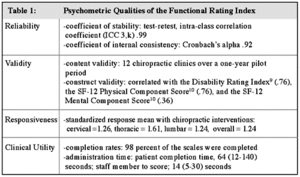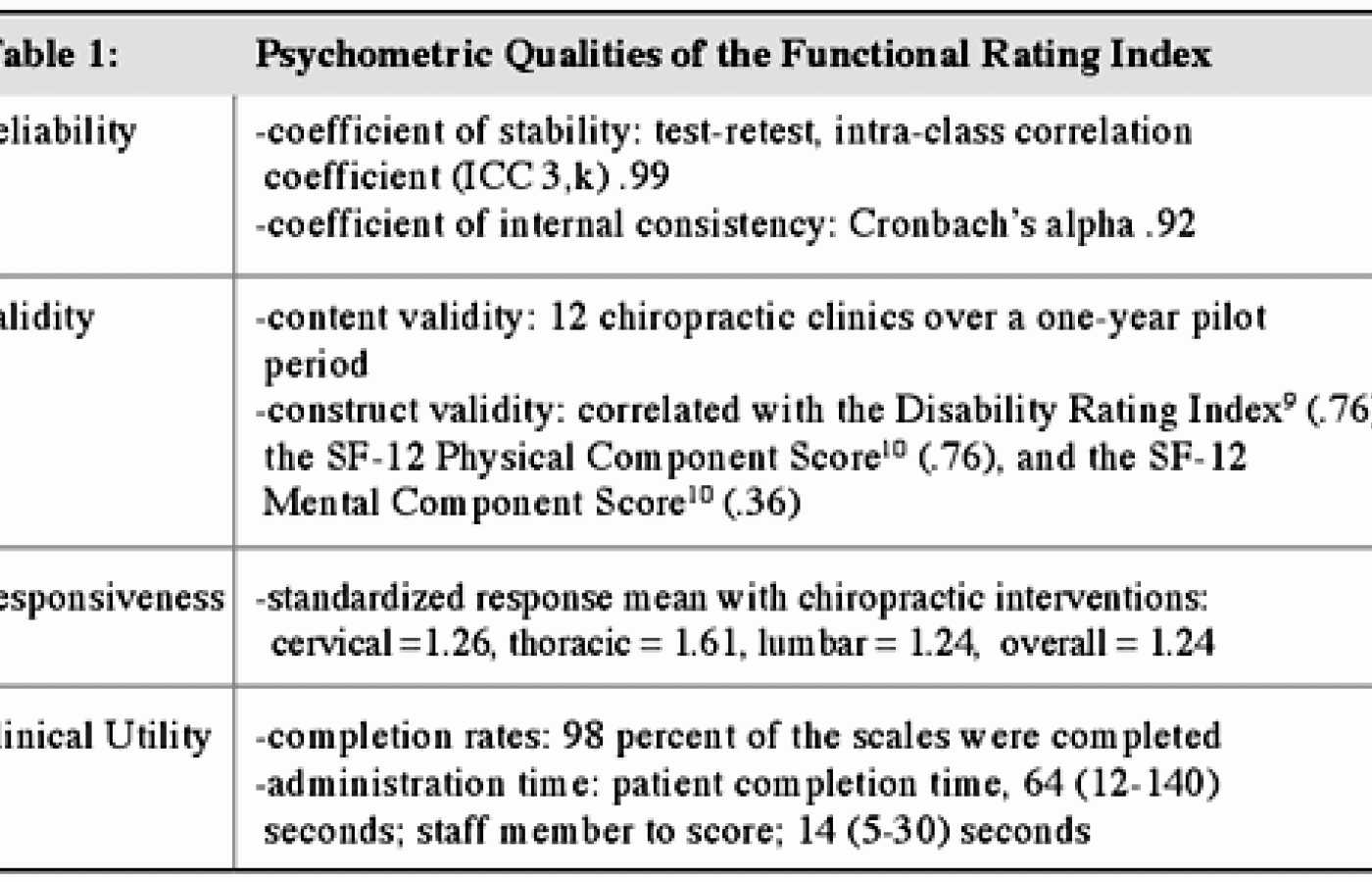New York's highest court of appeals has held that no-fault insurers cannot deny no-fault benefits where they unilaterally determine that a provider has committed misconduct based upon alleged fraudulent conduct. The Court held that this authority belongs solely to state regulators, specifically New York's Board of Regents, which oversees professional licensing and discipline. This follows a similar recent ruling in Florida reported in this publication.
A New Valid and Reliable Instrument: A One-Minute Spinal Index
Although chiropractors may continue their traditional emphasis on the structure of the body, it is vitally important for them to understand the everyday functioning and pain of the patient and to have a method of quantifying those items. Function is considered the most important measure of severity,1 and pain is the most common measure.2 Patient-centered outcome instruments are now widely recognized as valuable assessment tools for researchers, doctors, patients and payors. Employing and assessing the patient's perception is considered vital in judging the end point of therapy.
A patient's self-evaluation may be more accurate than the clinical, biochemical or physiological indexes that we have traditionally relied upon.3 Patients, however, can exaggerate responses on questionnaire instruments and distort tests that measure strength, endurance or range of motion. Moreover, "objective" findings from x-rays and physiological tests suffer from low reliability and/or validity scores,4,5 and are not well correlated with items that concern patients (patient outcomes) or society.6 Even a patient's ability to return to work, which might be considered pertinent to all stakeholders and more objective than a patient's perception, suffers from the confounding of social factors.1 Patients and payors, in general, do not care whether a patient has a negative SLR or a 25 percent increase in ROM. Patients and payors want the patient to be able to perform daily activities and participate in life without pain or restriction.
The need to measure the function of the neck and back, and to demonstrate clinical effectiveness, has resulted in many reliable and valid patient report instruments being produced in the last 20 years.7
Yet, existing self-reporting instruments measuring spinal pain and dysfunction are underutilized in daily practice, because they require too much time for patients to answer (5-10 minutes per instrument) and health care workers to score (1-5 minutes per instrument).8 Patients become exhausted when they have too many time consuming forms to fill out. Especially on a patient's initial visit, the doctor needs to "bond" with the new patient. Burdening the patient with an unnecessary administrative assignment only serves to diminish the patient's initial impression of the practice. Even the best clinician in the world will have fewer patients if collecting the patient data is too burdensome! The fact that many patients have symptoms in multiple anatomical regions compounds the problem of clinical utility, compelling the conscientious doctor to use separate instruments to assess low back and neck conditions.
A new instrument, the Functional Rating Index (FRI) combines the content of the Oswestry Low Back Disability Questionnaire and the Neck Disability Index in a format that reduces the administrative burden. The FRI instrument contains 10 items that measure pain and function of the spinal musculoskeletal system: eight refer to activities of daily living that might be adversely affected by a spinal condition; two refer to different attributes of pain. Because many spinal disabilities are most likely a combination of loss of function and pain and/or the fear of pain, employing both pain and function allows for a wider view of a patient's disability.
| The FRI is available royalty-free for noncommercial use by solo practitioners and small groups of health care providers. You can download the instrument at www.chiroevidence.com. |
The FRI has recently been tested, and the results have been published in Spine.8 Based on the initial research, FRI demonstrates excellent reliability, validity and responsiveness with chiropractic interventions and significantly reduces administrative burden (see Table 1). The FRI requires only about one minute for a patient to complete, and about 20 seconds for a health care worker to score. This is the first instrument that can be used with cervical, thoracic or lumbar conditions, which reduces the need for multiple instruments for spine-related conditions.

The practice of evidence-based chiropractic is becoming the standard of care, and outcome measures are the universal language for communicating the effectiveness of care over time. To establish proof that you get people better, faster and cheaper, with greater patient satisfaction, you need to employ a valid and credible scientific measurement. If you want to provide an option to the people who are dissatisfied with regular medical care, you must demonstrate value, reasonable cost and quality care.
By using a clinically meaningful outcome measure at the initial assessment and measuring change over time, you can obtain valuable information regarding the patient's progress, and thereby improve clinical decision-making. You will know whether a patient is functioning better as a result of a given clinical intervention. And you can use this information to document necessity (which can improve and facilitate reimbursement), modify your treatment regime and provide a rationale for ongoing treatment. This information can also confirm failure to respond to treatment or the progression of the disorder, thereby triggering the need to refer the patient to another health care practitioner for further evaluation or treatment. Additionally, if symptoms remain unchanged in any two successive two-week periods, you can pursue a change in management.
Remember that the majority of the costs in back conditions arise from the minority of the patients who are nonresponders.11,12 Outcome measures are particularly useful in establishing maximum therapeutic recovery or transition of care from acute to chronic or supportive care. Therefore, they play a key role in reducing costs associated with ongoing care. Moreover, the efficacious use of outcome measures can establish credibility and position your clinic to gain market share with patients, medical doctors, managed care organizations, and large employers.
Acknowledgement: I gratefully acknowledge Robert Cooperstein, MA,DC, for his manuscript review.
About the author: Dr. Feise is president and a postgraduate faculty member of the Institute of Evidence-Based Chiropractic. He is also research director of the American Chiropractic Scoliosis Foundation. Dr. Feise is published in peer-reviewed chiropractic and medical journals, and has presented at chiropractic research conferences. He can be reached at rjf@chiroevidence.com
References
- Waddell G, Main CJ, Morris EW, Paola MD, Gray ICM. Chronic low back pain, psychological distress, and illness behavior. Spine 1984;9:209-13.
- Roach KE, Brown MD, Dunigan KM, Kusek CL, Walas M. Test-retest reliability of patient reports of low back pain. JOSPT 1997;26:253-9.
- Epstein AM. The outcomes movement - will it get us where we want to go? N Engl J Med 1990;323:266-70.
- Bogduk, N. Musculosketal Pain: Towards precision diagnosis. In: Jensen TS, Turner JA, Wiesenfeld-Hallin Z, editors. Progress in Pain Research and Management, volume 8. Seattle: IASP Press, 1997:507-25.
- Deyo RA, Anderson G, Bombardier C, et al. Outcome measures for studying patients with low back pain. Spine 1994;19:2032S-6S.
- Deyo RA. Measuring the functional status of patients with low back pain. Arch Phys Med Rehabil 1988;69:1044-53.
- Millard RW, Jones RH. Construct validity of practical questionnaires for assessing disability of low-back pain. Spine 1991;16:835-8.
- Feise RJ, Menke JM. Functional Rating Index: A new valid and reliable instrument to measure the magnitude of clinical change in spinal conditions. Spine 2001;26:78-87.
- Salen BO, Spangfort EV, Nygren AL, Nordemar R. The disability rating index: an instrument for the assessment of disability in clinical settings. J Clin Epidemiol 1994;47:1423-34.
- Ware JE, Kosinski MA, Keller SD. A 12-item short-form health survey: construction of scales and preliminary tests of reliability and validity. Medical Care 1996;34:220-33.
- Torstensen TA, Ljunggren AE, Meen HD, Odland E, Mowinckel P, Geijerstam S. Efficiency and costs of medical exercise therapy, conventional physiotherapy, and self-exercise in patients with chronic low back pain: a pragmatic, randomized, single-blinded, controlled trial with one-year follow-up. Spine 1998;23:2616-24.
- Carey TS, Garrett JM, Jackman AM. Beyond the good prognosis: Examination of an inception cohort of patients with chronic low back pain. Spine 2000;25:115-20.



